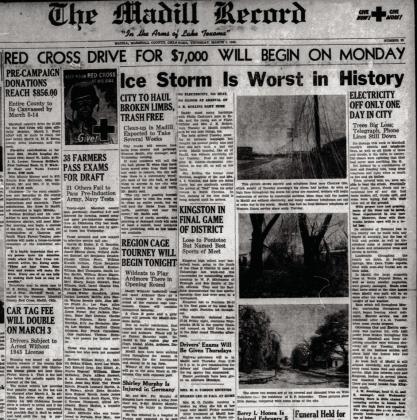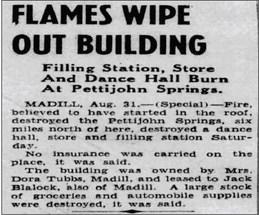After the troubles at Pettijohn Springs, Dora Tubbs branched out into other business opportunities after growing weary of the challenges of running the park. In 1936, Dora bought Jack Blalock’s interest in the Corner Drug Store in Madill, and Jack opened a livestock sale and feed barn in Madill. Despite operating the Corner Drug Store, Dora continued to operate the park for the 1936 season, as well as 1937 and 1938, until the first of August 1938.
At the beginning of August, Jack Blalock closed his livestockoperationandbegan runningPettijohnSpringsfor Ms. Tubbs. Then, in October of 1938, it was announced that Jack Blalock had leased the park from Dora Tubbs under a five-year lease agreement. Following the execution of the lease agreement, Dora Tubbs moved from her home at the park to Madill, and Jack Blalock moved his family from Madill to one of the park's homes.
Jack immediately announced plans for several park updates and a new schedule of dance parties. Blalock planned dances on Wednesday and Saturday nights, and he planned for a live orchestra for each session instead of music from the nickelodeon.
Another of Blalock’s canges was entering into a sort of consignmentagreementwith Texaco to make the Pettijohn SpringsTexacostationpartof a larger network of stations. This would help reduce his operating costs and allow him to negotiate with other stations for parts, supplies, andmore.TheConsigneewas R.A. Beaton, Jr. The stations consigned to Beaton included several stations in Ardmore and stations in Marietta, Thackerville, Springer, and more.
Jack Blalock also reversed Dora Tubbs's practice of not advertising in Marshall County newspapers and began advertising the dance sessions in the Madill Record. However, he continued to place occasional ads in newspapers in other areas. Blalock seemed more interested in drawing patrons from the Marshall County area than from other locations.
Blaylock’s push to draw more locals to the park worked. Attendance at the dances improved, and the Wednesday and Saturday night dances were well attended. The live music also improved the experience of those attending, and that, too, seemed to increase attendance.
The pool and picnic grounds remained popular with local families and weekend travelers. Birthday parties, family outings, church groups, school groups, and civic organizations continued to utilize the park in large numbers.
It appears the park was back on the right track for the remainder of the 1938 season. Then, in January of 1939, things began to go south again.
During the months of January through May of 1939, there were frequent incidents requiring the intervention of law enforcement. In January, several people were arrested for disturbing the peace charges. Then, in February, there were arrests for public drunk and disturbing the peace.
In March, numerous individuals were arrested for disturbing the peace, fighting, public drunk and driving under the influence. It appears every Saturday night, law enforcement was called to the park for some sort of criminal activity.
This criminal trouble continued into April and May, with multiple people being arrested for fighting and drunkenness.
Jack Blalock had clearly abandonedthepromisemade during his recent campaign for Sheriff of Marshall County. When he ran for Sheriff months before, he promised: “I will shut down the open saloons. I believe that it is the sheriff’s duty to assist in keepingdrunksoffthestreets and highways. When I am elected, I will, to the best of my ability, assist in that.”
Blalock continued Dora Tubbs's practice of selling beeratthenightlydancesand feeding alcohol to patrons, which contributed to the problems requiring the intervention of law enforcement.
These legal troubles continued throughout the remainder of 1939. However, it appears that Blalock may have dropped beer sales at the park beginning in the 1940 season, as there are no public records indicating issues or law enforcement intervention at the park.
Attendance at the park for swimming and picnics seemed to continue normally, and dances were well attended.
In May of 1940, the park hosted over 200 “oil men” at a picnic and dance sponsored by the City of Madill. The city was trying to lure oil exploration in the area, and the event was one such effort. “Oil Men” from across a multistate region attended the event over one weekend during May. Lunch was served, swimming and other events were hosted, and a dance was held until late at night. The event seemed a huge success.
In July, Jack Blalock upgraded the park's utilities by addingnaturalgastoheatthe dance hall, service station, pool houses, and cottages. It appears everything was on the upturn. Then tragedy struck again, and Pettijohn Springs Amusement Park was forever changed.
Overnight on August 31, 1940, a fire of unknown origin broke out in one of the public buildings at the park. Before the fire department could respond, the Texaco Service Station, the store, and the dance hall were all destroyed. Eachbuildingwasacomplete loss, as were all the goods in the store, automobile parts in the service station, and furniture and fixtures in the dance hall. Nothing could be salvaged. Thankfully, the fire did not spread to the pool house, the tourist cottages or the two homes at the park, but all the other structures were destroyed.
To make matters worse, Dora Tubbs did not have sufficient insuranceonthebuildings, andBlalockdidnothave insurance on the contents of any of the buildings. This would make reconstruction difficult because no funds were available to help cover the costs.
In early September, Dora Tubbs promised to rebuild. In the September 5, 1940, edition of the Madill Record, Tubbs stated: “If I can secure proper financing, I plan to rebuild the store and dance hall, putting up a better building that will be exclusive.”
Sadly, Dora Tubbs never rebuilt any of the burned-out structures at the park, and dances were never held again at Pettijohn Springs. The grocery store and service station were also never rebuilt. All that was left at Pettijohn Springs was the swimming pool and picnic grounds. And while families and civil organizations still frequented those attractions, the park's real money-making operation was gone.
Jack Blalock continued to operate the pool and picnic grounds for the 1941, ’42 and ’43 seasons, but he was not making any money. Dora Tubbs’s inability to rebuild the dance hall and service station made the park unprofitable.
At the end of 1943, when Blalock’s five-year lease expired, heabandonedthepark and moved back to Madill. He then negotiated to buy out Dora Tubbs’s interest in theCornerDrugStore,andin December1943,JackBlalock and Dr. F. L. Rice became co-owners of the store.
Dora Tubbs then returned to her home at Pettijohn Springs, where she operated the park for swimming, picnics, and other civil and fraternal functions. Then tragedy struck one more time in late February of 1945.
The worst ice storm in Marshall County's history occurred on the weekend of February 24-25, 1945. The ice storm caused devastation across all of Marshall County and a large section of Southern Oklahoma and Pettijohn Springs did not escape the carnage.
Trees, some hundreds of years old, were felled all throughout the park. In the Madill Record on March 1, 1945, it was reported that “Landmarks throughout the county are down. At Pettijohn Springs, Dora Tubbs reports, trees with man-size trunks are on their sides.”
Following the extensive parkclean-up,DoraTubbsremained for a few more years, operating only the pool and picnic grounds. Sadly, these operations did not generate any real revenue, and in May of 1950, Dora sold Pettijohn Springs to two businesswomen from Ardmore.
Dora Tubbs owned the park from 1929 to 1950. During those years, the park was beset by tragedy after tragedy, from the death of Anna Lou Sudberry to fights, arrests, robbery, burglary, and fire and ice. Nature and bad luck were the enemies of Dora Tubbs’ tenure as owner of Pettijohn Springs.
After the sale, Dora Tubbs moved back to Madill, where she lived out the remainder of her life. She passed thirteen years later, on July 1, 1963, at the age of 84.
Next week, Pettijohn Springs comes to Wits-End.


